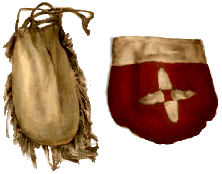
Leather Bags and Pouches
[Miles: 1963].

|
Leather Bags and Pouches |
[Miles: 1963]. |

|
Penobscot [Speck: 1976] |
Natives of Northeastern North America use bags and pouches to contain many of life's necessities around the home site and for travel. As Native American clothing did not incorporate European- like pockets, pouches of all shapes, sized and materials served this purpose. European explorers of North America in the early 1600's observed that Natives "Always carry with them all their goods, as well as their food and green tobacco." (de Laet: 1967) Pouches and bags were commonly fastened to a belt around the waist. Smaller pouches may have been worn around the neck or on the wrist. Bags that were not woven were traditionally made from tanned leather, animal bladders, and all types of furred animal hides from the mole to the bear. Pouches could contain food-stuff, smoking supplies, medicine, fire-starting equipment, ammunition, and other small tools and supplies used by men and women.

|
Crow [Lowie: 1954] |
A long leather bag was used to hold nokake (parched and powdered corn meal to be mixed with water and eaten. The parched corn bag was carried by Native American men when they traveled. The parched corn was "put into a long leatherne bag, trussed at their backe like a knapsacke"(Wood: 1865). Meals of parched corn while traveling consisted of three spoonfuls, three times a day.
A tobacco pouch is called Petouwassinug by the Narragansett of southern New England. In the 1600's Native American men wore a tobacco pouch "which hangs at their necke, or sticks at their girdle, which is to them in stead of an English pocket" (Williams: 1973). In 1622 Massasoit, a Wampanoag, wore a little bag of tobacco attached to "a great chain of white bone beads about his neck." (Heath: 1986) A separate pipe bag would be made and decorated to hold a smoking pipe, "for generally all the men throughout the Countrey have a Tobacco-bag, with a pipe in it, hanging at their back" (Williams: 1973)
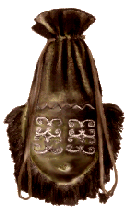
|
with Moose Hair Decoration Penobscot [Speck: 1976] |

|
Lakota ~ 1800's [Monture: 1993] |
At the onset of the 17th century in northern Virginia, every Native American man carried a mineral stone, in a leather case at his wrist or in a woodchuck skin which hung from a belt with which he could quickly start a fire (Russell: 1980). In 1637, a strike-a-light pouch was fastened to a belt so the ability to start a fire was always at hand: "and with a girdle of their making, bound round about their middles, to which girdle is fastned a bagg, in which his instruments be, with which hee can strike fire upon any occasion" (Morton: 1964). Beaded strike-a-light pouches, rectangular in shape, decorated with tinkling cones or fringe and having short flaps, were used through the 1800's by the Lakota, Apache, and other groups to carry a strike-a-light steel, a flint, matches and often ration coupons (Monture: 1993).
With European contact, most men carried powder horns and shot bags suspended by a wide strap from their shoulders, for use in both hunting and in preparation for war. Some shot bags were also called bandolier bags as they were often suspended from men's sashes worn over the shoulder, often accompanied by a black powder horn. With continued European contact and their production for trade, these bags were made from broadcloth and they acquired the name possibles bags, or Assumption bags, so named for their place of manufacture.

|
Crow [Miles: 1963] |
A sheath of leather and raw hide was often made for knives, awls, or other tools used by Native American men and women. Women's awls were commonly made from the ulna (having the perfect built-in handle) or split long bone of a large mammal such as a deer. The awl is an essential multi-task tool, and woman traditionally wore the awl in a decorated case on a string around her neck or from her belt. In 1622, the European, Mourt takes notice of a leather sheath and a suspended leather knife sheath and a "great long knife", which Massasoit (a Wampanoag of the east coast), "had in his bosom, hanging in a string" (Heath: 1986). Native women living in the Great Lakes region, and in other areas of the Northeast, wore knife sheaths suspended from a belt at their waist (Hartman: 1988).
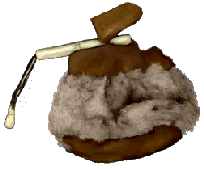
| Bags and pouches would also contain other necessities such as paint pigments, animal or nut oil, small tools like that for sewing. Pouches often contained bone needles. Needles were often kept in special cylindrical cases; a leather strap is wrapped around the needles and slipped through the cylinder, so pulling on the strap carries the needles in and out of their case. Pouches are also made for innumerable kinds of medicine. In the 1600's, a Native in southern New England was observed to have a necklace with a curative 'taffetie' bag containing tree frogs to "stop women's overflowing courses"(Lindholdt: 1970). |
needlecase and finger-stall type thimble [Miles: 1963] |
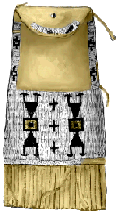 | 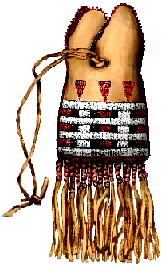 |  |
Arapaho [Lowie: 1954] | Blackfoot [Thomas: 1986] | Arapaho [Lowie: 1954] |
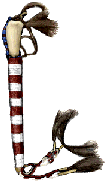
|
Plains [Miles: 1963] |
Many kinds of beads and ornaments were used to decorate Native American clothing and accessories. Europeans in New England in the 1600's described the applique of Native made beads, pieces of whales' fins, whale bones, and wampum, sewn onto leather; though beaded clothing was traditionally 'bad to wear for everyday use'. In the Northeast, tufts of red dyed deer hair is inserted into metal tinkling cones and attached to bags. The 'jingle' dresses of Plains Natives, originating with historic tobacco lids, continues the tradition of tinkling cones today. In the Eastern Forests, pouches were traditionally decorated with embroidered dyed porcupine quills and white moose-hair embroidery, although these industries were not as common in the 1700's after the splint basket replaced birchbark containers, the traditional canvas for porcupine quills. As soon as they were available through trade with Europeans, glass beads, buttons, ribbons, thimbles and many other items were quickly adopted for ornaments by Native Americans to decorate their clothing and bags.
|
|
You can also learn about Native American Puzzle Pouches

|
Text and Graphics
© 1994 - Tara Prindle unless otherwise cited. |